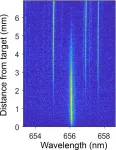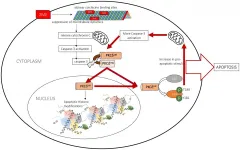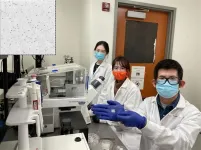(Press-News.org) Michelle O'Malley(link is external) has long been inspired by gut microbes. Since she began studying the herbivore digestive tract, the UC Santa Barbara chemical engineering professor has guided several students to their doctoral degrees, won early and mid-career awards (including a recognition from President Obama), attained tenure and advanced to the position of full professor. She even had three children along the way. A constant through it all: goat poop.
"This has been the longest single effort in my lab," said O'Malley, who with her research team way back in 2015 first embarked on an ambitious project to characterize gut microbes in large herbivores. The purpose? To understand how these animals manage, via their microbiomes, to extract energy from plant material, particularly the fibrous, non-food parts, where sugars are locked behind tough plant cell walls. Understanding this process could reveal methods for extracting the raw materials necessary for a wide variety of the chemicals required for modern life -- from biofuels to pharmaceuticals -- all from abundant, renewable, plant parts. This, in turn, could decrease or even eliminate our reliance on more finite resources for these materials.
Now, O'Malley has reached another milestone. In a paper(link is external) in the journal Nature Microbiology, she and her team report the results of more than 400 parallel anaerobic enrichment experiments, which include more than 700 previously unknown microbial genomes and thousands of new enzymes, as well as a possible mechanism for much of the methane often blamed on cows and goats.
Microbial Roll Call
"One of the things we wanted to do with this study was to ask ourselves if we could learn the bioprocessing lessons that the goat digestive tract has to offer," O'Malley said. Like all ruminants, goats have gut microbiomes that have evolved over millions of years to secrete powerful enzymes that break down tough plant parts, allowing the animals access to nutrition from a variety of vegetation.
"The aim of the study is really to learn about the microbes, and, importantly, the teams of microbes that do those difficult jobs," she said.
Of particular interest to the researchers were the non-bacteria denizens of the goat gut microbiome -- "minor players" like anaerobic fungi that constitute a tiny fraction of the bacteria-dominated population. Not only are these members of the community few and far between, they are difficult to culture, O'Malley said. So while gut microbiome research has been going on for a long time, most studies ignore the contributions of rare members of the microbiome.
"Nobody had really looked at the effects of these rare members," she said.
Over roughly 400 parallel enrichment experiments on fecal matter contributed by Elway, a San Clemente Island Goat named who lives at the Santa Barbara Zoo, the researchers teased out populations of biomass-degrading microbes with different biomass substrates. They further sculpted some of these populations using antibiotics to inhibit the growth of bacteria, leaving rarer microbes such as fungi and methanogens (single-celled organisms from the domain Archaea) to dominate.
"And then we sequenced all of those cultures," O'Malley said. "We put the fragmented DNA sequences back together again to reconstruct high-quality genomes, and that gave us a collective picture of who was there. Then we scanned these genomes for enzymes and pathways that gave us a clue as to what each microbe was doing in the microbiome." The O'Malley lab researchers sequenced these samples at the Department of Energy Joint Genome Institute (JGI(link is external)) as part of the JGI Community Science Program(link is external); they collaborated with JGI experts in metagenome sequencing and fungal genomics for this study.
In the process, the team uncovered more than 700 novel microbial genomes "unique at the species level," according to the study. Also present were rare fungi they had previously isolated from large herbivores.
"But this was the first time we had really seen them in action, in their normal community," O'Malley said.
Heavy Hitters
For their small population, fungi, it turns out, play a disproportionately large role in biomass degradation.
"They produce the lion's share of the biomass degrading enzymes that the community relies on to function," O'Malley noted. Additionally, according to the paper, fungi have other strategies, such the ability to physically penetrate plant cell walls, exposing surfaces for these enzymes to act on.
The researchers also found that along with the increased rate of biomass degradation came an increase in methane production in the fungal-dominated consortia. While both gut bacteria and gut fungi form cross-domain partnerships with methanogens, essentially passing carbon to the archaeans that ferment it into natural gas, fungi seem to be more efficient at it.
"We think the fungi are more effective at shunting carbon to methane," O'Malley said. "In other words, fungi are not producing a bunch of side products like bacteria would. Bacteria produce additional short-chain fatty acids and other chemical products, in addition to some methane. But, the fungi may have a more direct route passing materials to the methanogens." This, according to the paper, suggests that "fungi play a larger role in methane release than previously recognized."
These and other insights from the research take us closer to developing technologies using microbes to create industrially important chemicals from cellulose, the most abundant organic compound on the planet. O'Malley and her group are focused on understanding the roles of and interactions between members of these complex ruminal communities, and they're looking to a future where designed microbial communities can create value-added chemicals.
"Can we build a bio-reactor that houses not just one type of microbe, but a few, or dozens? Can we do really complex chemistry the way nature does? That's kind of the ultimate goal here," O'Malley said.
INFORMATION:
Research in this paper was conducted also by Xuefeng "Nick" Peng, St. Elmo Wilken, Thomas S. Lankiewicz, Sean P. Gilmore, Jennifer L. Brown, Joh K. Henske, Candice L. Swift and David L. Valentine of UC Santa Barbara; Asaf Salamov, Kerrie Barry and Igor V. Grigoriev of the Department of Energy Joint Genome Institute at Lawrence Berkeley National Laboratory; and Michael K. Theodorou of Harper Adams University in the U.K. The research was funded by grants from the National Science Foundation, the Department of Energy through the Joint BioEnergy Institute (JBEI) at Lawrence Berkeley National Laboratory, the Institute for Collaborative Biotechnologies (ICB), and a New Partnership grant from the California NanoSystems Institute (CNSI) on the UC Santa Barbara campus.
Over the past century, a wide variety of models have emerged to explain the complex behaviours which unfold within atomic nuclei at low energies. However, these theories bring up deep philosophical questions regarding their scientific value. Indeed, traditional epistemological tools have been rather elaborated to account for a unified and stabilised theory rather than to apprehend a plurality of models. Ideally, a theory is meant to be reductionist, unifying and fundamentalist. In view of the intrinsic limited precision of their prediction and of the difficulty in assessing a priori their range of applicability, as well as of their specific and disconnected character, traditional ...
RESEARCH TRIANGLE PARK, N.C. -- Army-funded researchers discovered how to make materials capable of self-propulsion, allowing materials to move without motors or hands.
Researchers at the University of Massachusetts Amherst discovered how to make materials that snap and reset themselves, only relying upon energy flow from their environment. This research, published in Nature Materials and funded by the U.S. Army, could enable future military robots to move from their own energy.
"This work is part of a larger multi-disciplinary effort that seeks to understand biological and engineered impulsive systems that will lay the foundations for scalable methods for generating forces for mechanical action and energy storing structures and materials," said Dr. Ralph ...
WASHINGTON -- In a new study, investigators report an optimized approach to using laser-induced breakdown spectroscopy (LIBS) for analyzing hydrogen isotopes. Their new findings could enable improved rapid identification and measurement of hydrogen and other light isotopes that are important in nuclear reactor materials and other applications.
LIBS is promising for measuring hydrogen isotopes because it requires no sample preparation and data can be rapidly acquired with a relatively simple experimental setup. However, quantifying the concentration of hydrogen ...
Oncotarget published "The pro-apoptotic actions of 2-methoxyestradiol against ovarian cancer involve catalytic activation of PKCδ signaling" which reported that the authors have previously shown that a flaxseed-supplemented diet decreases both the incidence and severity of ovarian cancer in laying hens, also induces CYP1A1 expression in liver.
Recently, they have shown that as a biologically derived active component of flax diet, 2MeOE2 induces apoptosis in ovarian cancer cells which is partially dependent on p38 MAPK.
The objective of this Oncotarget study was to elucidate the molecular mechanism of actions of 2MeOE2, a known microtubule disrupting agent, in inducing apoptosis in ovarian tumors.
The objective of this ...
Each year, billions of tons of goods are transported globally using cargo containers. Currently, there are concerns that this immense volume of traffic could be exploited to transport illicit nuclear materials, with little chance of detection. One promising approach to combating this issue is to measure how goods interact with charged particles named muons - which form naturally as cosmic rays interact with Earth's atmosphere. Studies worldwide have now explored how this technique, named 'muon tomography,' can be achieved through a variety of detection technologies and reconstruction algorithms. In this article of EPJ Plus, a team headed by Francesco Riggi at the University of Catania, Italy, build on these results to develop a full-scale muon tomograph ...
As the numbers of those infected with COVID-19 has continued to climb, the desperate need for a vaccine was apparent. Even now with the invention and administration of several COVID-19 vaccinations, the question remains: How effective are these vaccines? HMNTL students Congnyu Che, Weijing Wang, and Nantao Li, also members of the ECE Nanosensors Group, along with Postdoctoral Researcher Bin Zhao and Professor Brian Cunningham have recently been published in Talanta journal for the development of a cost efficient COVID-19 antibody test.
"Compared with other detection methods, our method is a simple, 15-minute sample-to-answer test," says Zhao, a postdoctoral research associate and IGB Fellow. "It costs less ...
People who are unable to make their rent or mortgage payments sleep less than than their peers who don't have such problems, and those who are forced to move because of financial problems sleep even less, according to a new RAND Corporation study.
The study, which followed 1,046 people receiving welfare in California over several years, is the first to analyze the relationship between housing insecurity and sleep outcomes after controlling for sleep duration and sleep quality measured prior to experiences with housing insecurity.
The study found that people who were unable to make a rent or mortgage payment slept on average 22 fewer minutes a night than their peers who were able to make their rent or mortgage payments.
People who were ...
Richard Feynman, one of the most respected physicists of the twentieth century, said "What I cannot create, I do not understand". Not surprisingly, many physicists and mathematicians have observed fundamental biological processes with the aim of precisely identifying the minimum ingredients that could generate them. One such example are the patterns of nature observed by Alan Turing. The brilliant English mathematician demonstrated in 1952 that it was possible to explain how a completely homogeneous tissue could be used to create a complex embryo, and he did so using one of the simplest, most elegant mathematical models ever written. One of the results of such models is that the symmetry shown by a cell or a tissue can "break" under a set of conditions. However, ...
Theoretical physicists of the PRISMA+ Cluster of Excellence at Johannes Gutenberg University Mainz are working on a theory that goes beyond the Standard Model of particle physics and can answer questions where the Standard Model has to pass - for example, with respect to the hierarchies of the masses of elementary particles or the existence of dark matter. The central element of the theory is an extra dimension in spacetime. Until now, scientists have faced the problem that the predictions of their theory could not be tested experimentally. They have now overcome this problem in a publication in the current issue of the European Physical Journal C.
Already in the 1920s, in an attempt to unify the forces of gravity and electromagnetism, Theodor Kaluza and Oskar Klein speculated ...
PHILADELPHIA--Scientists in the Perelman School of Medicine at the University of Pennsylvania have uncovered the molecular causes of a congenital form of dilated cardiomyopathy (DCM), an often-fatal heart disorder.
This inherited form of DCM -- which affects at least several thousand people in the United States at any one time and often causes sudden death or progressive heart failure -- is one of multiple congenital disorders known to be caused by inherited mutations in a gene called LMNA. The LMNA gene is active in most cell types, and researchers have ...



